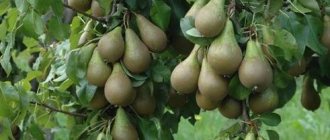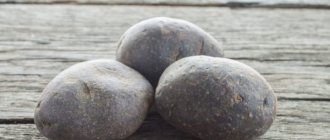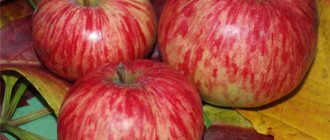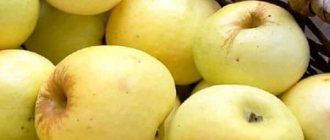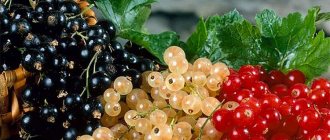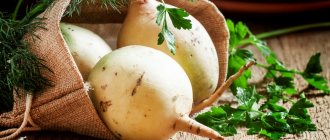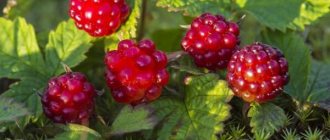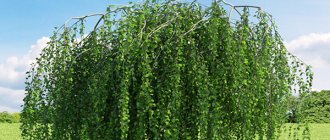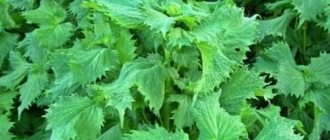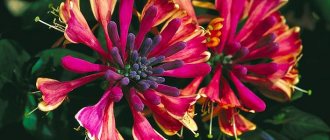If you remember the story of the fall of Adam and Eve, an apple comes to mind. Judging by the descriptions of the Fuji apple variety, it was these apples that could seduce the first people in the world. Juicy, fragrant, moderately sweet and unusually healthy - for several years the variety has gained immense fame all over the planet. But how to properly grow apple trees, and what properties made Fuji famous - read our article.
Honey taste, beautiful pink and smooth round barrels, unusually fragrant juice - all these qualities distinguish Fuji apples (there is a spelling of Fushi apples) from thousands of other apple varieties. The variety was developed in Japan, although now the variety is adored all over the world. American housewives bake branded pancakes with them, in Japan they make fresh juices. In China, they bake with the famous duck, while in Russia they eat it just like that. The fruits are extraordinarily good in various forms and are surprisingly healthy.
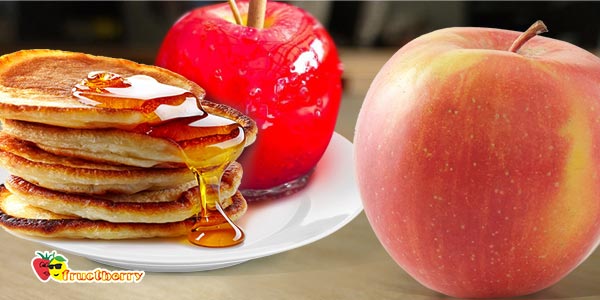
With all this, the brainchild of Japanese breeders - the Fuji tree is surprisingly unpretentious. If you wish, you can plant an apple tree in your own garden, and after a couple of years, treat yourself to juicy, self-grown fruits. We will tell you about the peculiarities of the variety, the rules of care, selection, in our material.
Advantages and disadvantages
The Fuji apple tree has won the hearts of consumers in many countries for a reason, it has a number of advantages. The main ones are:
- beautiful presentation and excellent taste of the fruit;
- long-term storage of the crop;
- crunchy sugary pulp;
- quick adaptation to new regions and climate.
Due to the high sugar content, the fruits are valued in factories that produce juices, purees, and canned fruit. Saplings are sometimes transported hundreds of kilometers away to grow delicious fruits in their garden.
The variety is not devoid of a number of disadvantages:
- the need for crown formation;
- the harvest is periodic;
- low resistance to disease;
- poor quality of the first harvests.
These few disadvantages do not interfere with growing apple trees on an industrial scale. After all, it is not difficult to sell products. Customers quickly sort it out in supermarkets.
Fuji apple tree: basic information
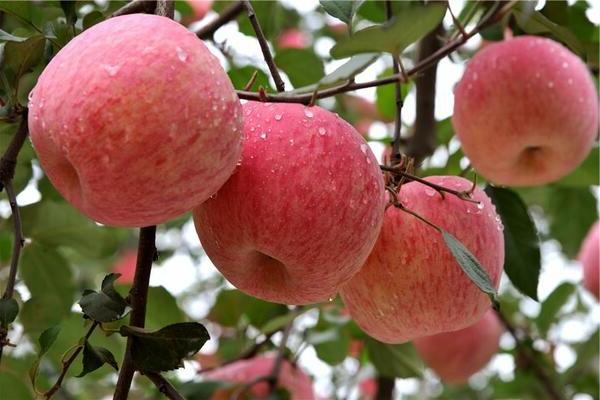

Fuji apple tree
Today it is very difficult to imagine any personal plot without a beautiful apple tree. Gardeners have a huge choice, they can find absolutely any varieties that suit their interests, desires, needs and expectations. In addition, you can choose a variety of trees that have different ripening periods, taste characteristics, external features, yield and transportation.
Every gardener dreams of effortlessly growing an excellent, strong tree that will bear fruit regularly and abundantly. He also wants to take minimal steps and efforts to protect the plant from pests, bacteria, or any other nuisance. One way or another, today there really is an incredible variety of apple varieties that have different characteristics, advantages and disadvantages. In this article, we will dwell in more detail on the description of a variety called Fuji, indicate its main and additional characteristics, and also identify the subtleties of planting and caring for this variety. This article will be informative not only for novice gardeners, but also for those who already have experience in planting and caring for apple trees, but they are still in search of completely new varieties.We will also talk about the varieties of this variety, since there are several of them today, and it will be interesting to consider what are their similarities, and what are the differences.
Characteristics of the variety
To better understand all the features of apples, carefully study their description.
It is worth saying that the Fuji apple variety was considered exotic for a long time in Russia, but now it is gaining more and more popularity among gardeners. Received a variety by crossing Hungarian Roll Janet and American Red Delicious. The variety retains some of the characteristics of its parents.
Description of the tree and fruit
Fuji's tree is tall and sturdy. The shape of the crown depends on the method of formation, it is round, columnar, spherical.
Height without pruning - 9 m, with pruning - 4-6 m. Bark color - light brown, with a slight gray tint.
- Young shoots are bright green, there are few lentils.
- The branches grow chaotically, in different directions.
- The surface of the trunk is slightly wrinkled.
- Leaf shape - lanceolate-oval or oval, pointed tips.
- The growing plates are pubescent, the formed leaves are smooth, glossy.
- The petioles are attached to the twigs at an acute angle.
Fuji apples stand out from others. Fruit weight - 200-250 g, diameter more than 7.5 cm. The shape is correct, round. The rind is dry and matte.
They have a very beautiful color: the main color is bright red, with a pink or crimson tint, yellow dots are present on the entire surface, as well as yellow and greenish blurred stripes - this is their characteristic feature.
The pulp is white or creamy, with a delicate texture. The core is medium in size, the seeds are thin, light.
Some apples grow into real giants. But within the same tree, the sizes are approximately the same.
Composition and calorie content of apples
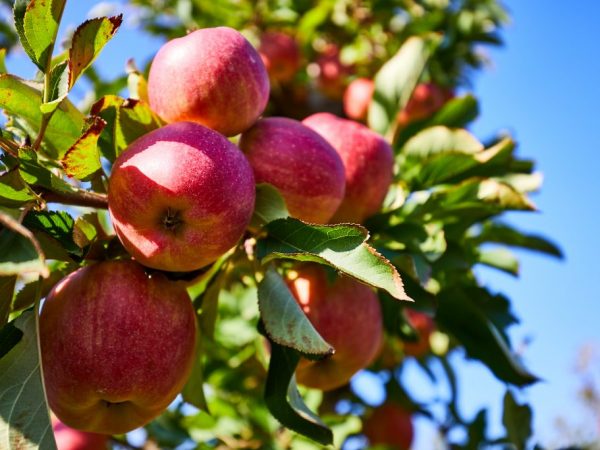

Fruits contain a lot of vitamin C
Fuji has a high sugar content - up to 9-11%, which affects the number of calories. 100 g of product contains 71 kcal.
The composition of the BZHU (per 100 g):
- proteins - 0.36 g;
- fats - 0.24 g;
- carbohydrates - 19.06 g.
Fruits contain a lot of potassium, up to 148 mg / 100 g. There is little sodium in them, only 1 mg. They also contain a lot of ascorbic acid, B vitamins, carotene.
The composition includes fiber, quercetin and other organic compounds.
Taste
Taste is one of the main advantages of the Fuji variety.
Apples are sweet and sour, with a bright, pronounced aroma. The redder the fruit, the more sugar it contains. The pulp is plump, juicy and crunchy, it remains so until spring and even until the beginning of summer when properly stored.
Tasters highly appreciate the fruit - 4.9-5 points out of five possible.
Useful properties and contraindications
The rich composition of apples provides their beneficial properties. Fiber is good for regulating bowel function, and dietary fiber lowers cholesterol levels. Quercetin is a cardioprotective agent that also lowers blood glucose levels.
Fruits are allowed to be eaten with diabetes mellitus. Not too high in calories allows you to use them for weight loss.
- Potassium normalizes heart function, enhances contractions, prevents heart attacks.
- Vitamin C is stored until the end of winter, when this compound is not enough in the diet. It strengthens the immune system, strengthens blood vessels, and improves skin condition.
- Vitamin A and carotene are great benefits for hair, eyesight.
- Group B - protectors of the nervous system, ensures normal hematopoiesis.
There are almost no contraindications to eating apples. They are not recommended for people with allergies to red fruits and individual intolerance.
It should be used with caution in case of intestinal diseases (Crohn's disease, ulcerative colitis, irritable bowel syndrome), the fruits can harm the body. In such situations, it is worth eating the apples not raw, but baked.
Yield
One tree can harvest 200-300 kg of fruit per season. But high yields are not observed every year.After abundant fruiting, the apple tree takes a break.
To consistently harvest, it is recommended to thin out the ovaries.
Pollinators
Like many other honeycomb apple trees, Fuji does not self-pollinate well. This is due to the genetic characteristics of the species. To maintain phenotypic diversity, evolution has provided for the incompatibility of pollen and pistils from the same tree.
The apple tree will bear fruit well if pollinators are planted nearby. Suitable for this variety:
- Ruby;
- Ligol;
- Gala;
- Red Delicious;
- Idared;
- Pinova;
- Grenie Smith;
- Everest.
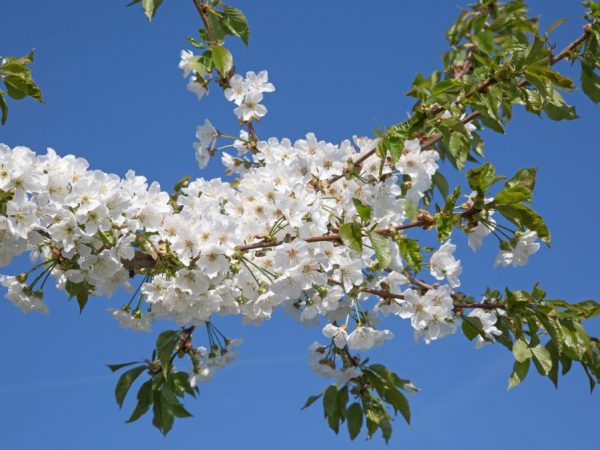

Pollinators increase yields
It is recommended to plant 1 pollinator for 10-12 trees. The distance between them should be 50-100 m. Sometimes they practice planting 1 row of the pollinator on 2-3 rows of the main variety.
Winter hardiness
Fuji variety has good winter hardiness. The tree is able to withstand frosts down to -25⁰С. It tolerates winter temperature drops, alternating thaws and cold snaps.
But long and lingering frosts can destroy the culture.
Winter hardiness of different clones may differ.
Disease and pest resistance
The variety is not very resistant to fungal and bacterial infections. Therefore, it requires constant preventive treatments.
Most often it is susceptible to:
- powdery mildew;
- bacterial burn;
- scab (medium resistance).
Products containing copper (for example, copper sulfate) help against fungi (scab and powdery mildew). The use of industrial fungicides is also recommended.
A bacterial burn is sensitive to antibiotics (gentamicin, rifampicin, streptomycin). But in many cases the tree cannot be saved.
Among the pests, the most dangerous are:
- apple flower beetle;
- green aphid;
- moth.
To get rid of them, the tree is treated with insecticides. Helps mulch and whitewash of trunks slaked with lime. In the fall, be sure to remove all the leaves.
Eggs and larvae of pests overwinter well under such a litter; it becomes a natural breeding ground for fungi and bacteria.
Growing regions
Although the apple tree is resistant to cold weather, it is not recommended to grow it in the northern regions. Even for the Moscow region, it is suitable only conditionally.
The fact is that for sugar content and red blush, she needs a lot of sun. The further north you go, the more sour the fruits will be.
In the USA, this variety is cultivated in the states of New York, California, Washington. There are many gardens in central China. It is perfect for Ukraine, south and center of Belarus.
In Russia, he fell in love with gardeners of Stavropol, Kuban, Krasnodar Territory, Caucasus, Bryansk, Rostov regions. Some modern clones have a shorter growing season; they have taken root in more northern regions, in the Central zone.
Tree lifespan
Standard tall trees live approximately 50 years. At the same time, they bear fruit for 30-40 years. Dwarf rootstocks are not so long-lived, after 25-30 years they stop yielding and dry up.
The shortest life span in the columnar type is up to 15-18 years. You can lengthen the growing season by rejuvenating the crown, dressing.
The composition and calorie content of Fuji apples
Fuji's honey and sweet apples are considered a high-calorie dessert.
The composition of 100 g of fruit contains 71 kcal. The lion's share is accounted for by fructose, in Fuji it is almost 11%.
Fuji's apple contains a lot of fiber and pectin useful for the gastrointestinal tract.
In addition, Fuji apples contain ascorbic acid, retinol, pyridoxine, pantothenic acid and folic acid, and apples also cover the daily dose of manganese, iron, potassium, magnesium and even iodine (apple seeds are famous for them). That is why doctors recommend introducing them into the diet of children living in Central Russia. Sometimes we do not have enough iodine, and Fuji apples help fill the lack of this valuable trace element, keep the thyroid gland healthy.


Landing
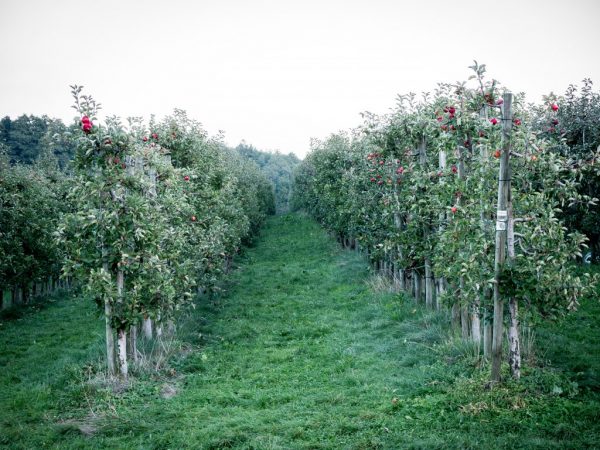

The variety is suitable for cultivation in the southern regions.
In order for young seedlings to take root, grow quickly and give a crop, they must be properly planted. There are no difficulties in growing Fuji apple trees, even a beginner can cope with all the stages.
Timing
You can plant trees in autumn or spring.
If you plant an apple tree in October, then by the spring its roots will strengthen and will nourish the young seedling. But in winter, the crown can freeze, and the trunk is often eaten by hares or other rodents. To prevent this from happening, the branches are carefully covered.
Spring planting begins in late March or early April, when the ground warms up well.
During the summer heat, the root system will have time to take root and begin to supply moisture to the branches. Such terms are more acceptable for regions with cool and temperate climates, for example, for the Moscow region or the Bryansk region.
Seat selection
The variety loves the sun, only in such conditions apples ripen well and gain a lot of sugar.
It is better to plant Fuji from the south side. The place should not be in the shade. The ideal option is a small hill, sheltered from the wind.
The soil on the site should be fertile, neutral or slightly acidic. The variety grows well on black soil, with minor admixtures of sand or clay.
It is advisable to choose a place with deep groundwater. If their level is higher than 1 m from the surface, the roots will rot and the seedling will die. To prevent this from happening, it is necessary to arrange good drainage and plant an apple tree in a shallow hole, fill in an artificial mound.
Landing technology
For planting, it is better not to take large seedlings, which are often brought to markets. Small trees, 1-2 years old, take root faster.
When buying, carefully inspect the roots, remove any broken and rotten ones. Prepare a 1% solution of copper sulfate and lower the tree in it for 4-5 minutes. After that, it will be completely ready for planting.
The hole should be dug 2-3 weeks earlier. If you plan to plant in the spring, the place should be prepared in the fall. The depth and width should be 60-80 cm. If the soil is clayey, a little river sand is placed on the bottom.
Good drainage from expanded clay or pebbles will not interfere. To increase the fertility of the soil, adding half a bucket of humus or well-rotted manure.
Before planting, a small mound is built at the bottom, the roots are straightened and the tree is planted on top. Sprinkle with soil so that the root collar protrudes slightly above its surface. Pour 2-3 buckets of settled water.
The distance between seedlings depends on the type of rootstock.
- If it is standard, you need to provide 4 m.
- For dwarfs, 3-3.5 m is enough.
- For columnar - 2.5 m.
The distance between the rows is 6 m, 4.5-5 m and 4 m, respectively.
Fuji apple tree: description of the characteristic features
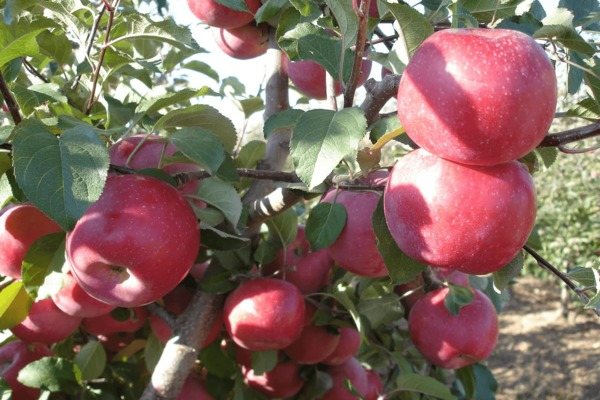

Fuji apple tree: description
The Fuji apple tree has some characteristics that we cannot just ignore. These features include the following:
- in order for the apple tree to develop normally, and at the same time, the fruits ripen normally, reach not only technical, but also to consumer ripening, on average they need about 3200 hours of lighting per year, that is, during this time on the apple tree and on the fruit should be exposed to sunlight. Therefore, the gardener should think very hard about in which region and in what place to plant this variety.
- in the first two years of fruiting, the level is not at all indicative for this apple variety. As a rule, the very first fruits have a very ordinary, even mediocre taste, and the external characteristics are not at all as bright and indicative as they become later.In the third year, the fruits gain maximum strength, absorb many useful and nutritious substances, and as a result acquire the same famous exquisite taste and unique aroma, for which they are appreciated among gardeners and gardeners from different parts of the world.
- it is worth paying attention to the color of the fruit. If the fruits are dark, burgundy in color, then this suggests that they have a very sweet pulp. If the apples are light, then the taste will have a pronounced sourness.
Fuji's tree is very tall, it belongs to the vigorous type. An adult Fuji apple tree can reach a height of almost nine meters, and this is an incredibly large figure. At the same time, nine meters is the maximum when there is no trimming of the tree and its shaping. If the gardener carefully monitors the condition of the tree and its external characteristics, then he will definitely form it, and therefore the height of the tree rarely goes beyond six meters. In addition, it is worth noting that the tree itself as a whole lends itself well to shaping, so this caring procedure is one of the most significant, and in no case can you just ignore it.
Also, the height of a tree usually depends on which rootstock it is based on. If it is a dwarf, well, or at least a semi-dwarf stock, then the height will vary from two to four meters, no more. The trees will turn out to be very compact and neat and, accordingly, a little less fruit will form on them. Although, in principle, it is worth noting that the fruits will retain their taste and external characteristics, they will be the same fragrant, sweet and large. It should also be borne in mind that at a younger age the tree demonstrates very active growth, but when it begins to bear the very first fruits, and the yield becomes more and more abundant every year, then growth can slow down noticeably. This is a completely logical pattern that you should definitely pay attention to, especially for novice gardeners who may not be aware of such subtleties.
The crown of a Fuji tree is distinguished by its majesty and density, it is very spreading, but the crown of a young tree can be round. Over time, under the weight of the fruit, the crown may become less compact, it begins to spread out, the branches grow in different directions, and the tree needs major pruning and shaping. In general, when forming, the gardener can independently decide for himself what shape of the crown he will form, and already starting from this crown it can remain as extensive and spreading, or it can become more round, compact. If we talk about the annual growth, then both the height and the width of the tree account for about 60 centimeters. If the tree grows in the most favorable conditions for itself, then the annual growth may be even higher. But when the tree enters the fruiting stage, the annual growth may decrease, and eventually come to zero.
Due to the incredibly attractive taste and aroma of the Fuji variety, this variety has become very popular far beyond Japan. Today it grows almost everywhere, except that different regions have their own techniques in order to preserve the tree, to make it even more fruitful. In the southern regions, the fruits can be fed with a lot of sugar, so they are very large and sweet. But in the north, the fruits become with a pronounced sourness, but this does not mean at all that they become completely sour and tasteless. The taste from the acid does not spoil at all, and some, on the contrary, say that if apples have sourness, then they can be eaten in much larger quantities than those fruits that have exceptional sweetness. In any case, it all depends on the taste preferences and preferences of the gardener, and on the purpose for which he grows this apple variety.
The Fuji apple tree is perfectly zoned on the territory of Ukraine and Belarus, as well as on the territory that is located near the Bryansk region. But still, it is worth choosing not the variety itself, but its clones, if we are talking about cultivation in Russia, since clones have more opportunities to normally adapt to conditions and show a really decent result in yield and subsequent storage.
By the way, it's time to talk about the yield of this variety. In general, Fuji himself is a high-yielding variety, but at the same time fruiting in trees is more periodic than regular. Thus, if the year was high yielding, then the next year, most likely, the tree will bear very little fruit, or it may not bear fruit at all. Of course, he needs a little respite in order to restore the strength and vital activity of his organs, and after that it will again begin to delight the gardener with its fruits.
If the gardener carries out mechanical thinning, then this will lead to the fact that an excessive crop load will be removed from the apple tree. The Fuji apple tree will feel much better and more comfortable and, as a result, fruiting from periodic to regular, annual, and then you can forget about this problem. But nevertheless, thinning should be taken with particular seriousness, since not all clones need it, and not all clones of the Fuji variety will treat this so positively. Of course, it is worth mentioning a few words about the tasting evaluations of this variety. Apples not only have a great appearance that is suitable for sale, but also have excellent taste characteristics. Fruits can be bright, pink, and can also be dark red, almost burgundy. The color largely determines how sweet the apple is, so it's worth paying attention to at this point.
The flesh of apples is white, with a creamy sheen, while it is very juicy, it can be absolutely sweet, and it can also have a pronounced sourness. However, it is very dense and crispy when bitten. Experienced gardeners give a tasting score of 4.9 points on a five-point scale. Not all varieties are awarded such an indicator, and therefore the Fuji variety stood out in a good sense. The apple tree of this variety also belongs to those types of varieties that can perfectly tolerate severe frosts. At the same time, the fruits can hang on the branches before the onset of severe frosts, they do not crumble, their tasting characteristics do not suffer from this in any way. The variety also withstands recurrent frosts, which usually appear in spring, when it seems that the weather has already stabilized, but sometimes it can deteriorate again between April and May. Also, in general, it is worth noting that if an apple tree grows in conditions where there is a high risk of extreme and prolonged frosts, then just such conditions can be very dangerous for the tree. Therefore, it is better or not to plant it at all in such areas, but to plant, but to protect the tree - wrap its trunk with fiber for thermal protection or take some other measures. One way or another, it is absolutely impossible to do without care measures on the part of the gardener, and this must be borne in mind.
It is also worth pointing out that frost resistance is a factor and an indicator that can be inherited by a tree. This means that Fuji clones will also be quite resistant to these conditions, so this is a huge varietal advantage to consider when a grower chooses a particular variety or hesitates.
The tree has a lifespan of up to fifty years. If we talk specifically about the period in which the tree gives a harvest, then it varies from thirty to forty years. At the same time, it is important not only the place in which the tree is planted, but also whether the gardener complied with all agrotechnical requirements and conditions.These include regular watering of the plant, periodic pruning (both formative and sanitary), treatment against bacteria, pests and fungi. As for the durability, it can also directly depend on the type of rootstock. For example, if a tree was grafted onto a dwarf or semi-dwarf stock, then it will have a shorter life and become less durable. Fruiting of such trees lasts for all fifteen years, which should also be remembered, and this fact should be taken into account when choosing rootstocks and seedlings. In general, as we have already noted, the agricultural technology of this variety is as simple as possible - it must be watered regularly and abundantly, the tree should be cut, shaping it, and also treated against pests and bacteria, so that it is easier for the tree to maintain its level of immunity.
Care rules
To get a good harvest, apple trees need to be properly cared for.
Watering
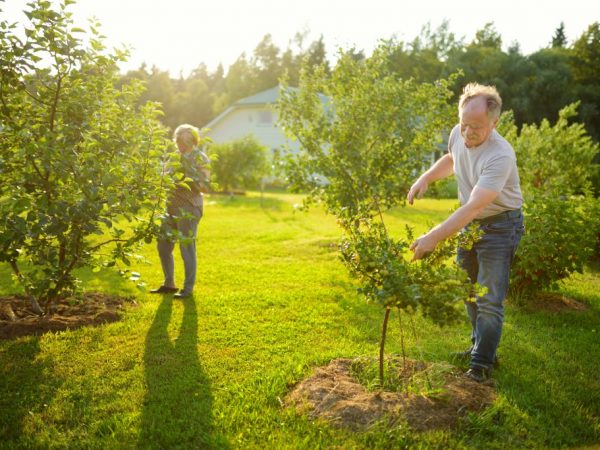

The tree needs to be well looked after
Trees are watered in dry weather, 3 to 10 times per summer. The amount of water depends on the age.
Under a seedling, it is enough to add 2-3 buckets of water, under a young apple tree - 5-7 buckets, and under an adult tree - up to 10 buckets.
After the procedure, be sure to loosen the soil. In the early years, a circle with a diameter of 80-100 cm from weeds is weeded.
Top dressing
Fertilizers are applied in spring and after harvest. The first feeding should contain a lot of nitrogen, which stimulates growth and green mass gain.
A nitrophoska or mullein diluted with water 1:10 will do. After the end of the growing season, potassium-phosphorus mixtures (superphosphate, potassium chloride) are introduced.
In late autumn, they make mulch from humus around the tree, it will protect the horses from the cold, and in the spring it will feed them well.
Crown formation
The variety has a tendency to thickening and improper growth of branches, therefore, special attention should be paid to the procedure. Pruning begins in the second year after planting.
The tiers are formed according to the following plan:
- stem height - 50-80 cm;
- between the first and second tiers - 60-80 cm;
- between the second and third - 20-30 cm.
In the first tier, 5 branches are left, in the second - 3-4, in the third - 2-3 shoots.
In the second year, the top is pruned to stimulate the growth of the lateral branches. All shoots are shortened by a third of their length. Formative pruning is completed in the fifth year. Then they do sanitary and anti-aging manipulations.
The tree is pruned in late February or early March, until the juices begin to circulate. Remove any shoots that are too close to the trunk, broken and showing signs of disease. Do not leave branches that are thicker than the central trunk.
Preparing for winter
Young trees in regions with cold winters are sheltered for the winter. It is recommended to use a special agricultural film.
Be sure to tie the trunk to protect it from rodents. Near the roots arrange a mulch of straw, high-moor peat with the addition of humus.
conclusions
- Fuji, Royalty and Ostankino are a prolific high-growth variety. In order for it to bear fruit equally well every year, it is necessary to form the ovaries.
- Frost resistance is high, so the culture grows normally in regions with harsh climatic conditions.
- The planting scheme is standard, you can do it in spring or autumn. Since the root system is branchy, you need to leave sufficient distance between the trees.
- Fuji apples have excellent taste and are best eaten fresh. In the refrigerator, the fruits lie in the flesh until May.
- The variety is prone to infection with scab, rot, fire blight. Preventive treatments are recommended.
Features of ripening and fruiting
After planting, the first fruits are harvested no earlier than 4 years later. By that time, the tree is growing. The crown is almost formed, there are 3 tiers of branches on the trunk.
If the apple tree blooms earlier, you need to pluck all the ovaries. Early fruiting can deplete the plant and it will die.
Fuji reaches its maximum yield at 15 years. Flowering begins late, in late April or mid-May.
Flowers form well if the average daytime air temperature is 15-22⁰С. Therefore, in the northern regions, they appear later. The period lasts 6-12 days (in hot weather it is reduced, and in cold and wet weather it is delayed).
The apples are pouring slowly. It is recommended at this time to spray the plant with nitrogenous and phosphorus foliar dressings. They not only contribute to a good harvest, but also prevent fungal diseases, repel and destroy pests.
If there are too many ovaries, the fruits will be small, and the next year the apple tree may not germinate at all. Therefore, it is imperative to thin them out. This is especially important in the early years.
Testimonials
Evgeniy, Penza region. “I would like to share my impressions of Fuji apples. You can't think of apples tastier. The variety is on everyone's lips, therefore, after a long search, we finally planted this miracle on our site. Knowing that dwarf trees begin to bear fruit earlier, we looked for a tree on a dwarf rootstock. The first fruits were harvested the next year, there were only 5 of them, but the taste is awesome (better than the purchased ones by 100 times), and the smell is the aroma of warm autumn throughout the cold winter. Now we will look for its varieties. "
Stepan, Saratov. “When laying an orchard, I chose (after receiving information from the Internet and reading reviews from the same place) on Fuji apple trees, Fuji Kiku and found another variety Fuji Beni Shogun. My impressions: the apple trees did not disappoint. The fruits are delicious, beautiful. They have become the most beloved of all available in the garden. There is only one drawback: as for me, the harvest is too small, I would like more. And so - the apples are sweet, juicy, crunchy. They are stored for a long time and without problems. Before storing, I do not process anything, which is important, there is no excess chemistry. We eat the last apples even at the beginning of spring.
In care, trees are also not capricious, in principle, like the rest: watering, spraying against pests and diseases, I do not forget about dressing, but I prefer foliar, combining them with chemical treatments. The trees are not tall, so pruning and harvesting is very convenient. I recommend everyone to plant this variety, I am sure they will like it. "
Irina, Belgorod region. “I tried Fuji apples, bought them in the supermarket, fell in love with the first bite. She tortured her husband while he found and wrote him out on the websites of online stores. We planted two trees Fuji and Fuji Kiku. Its fruits are even tastier than purchased ones - juicy, very tasty. But, unfortunately, we will get rid of the Fuji variety, compared to Fuji, Kiku loses in taste. After reading about him on the Internet, we realized that he lacks the sun in our area (I live in the Belgorod region). Instead, we will try to find other varieties of the variety, since the breeding work on one Fuji did not stop, there is something to choose from: Red Fuji, Yataka, Kiku-8 and others. "
Galina, Kirov. “I would classify this variety as the apple“ elite ”- for me the best. He conquered the delicate taste and aroma, and the juiciness of apples is generally a separate conversation. Moreover, after a long storage (end of winter) they remain the same strong and the juice in the fruits does not become less. They are very good in baking, they do not turn into porridge. "
Harvesting and storage


Ripe fruits taste sweet
Fruits ripen from late September to late October, depending on the climatic zone. They are not prone to falling off.
The longer the fruit hangs on the branches, the redder and sweeter they become. They need 3200 hours of sunshine to fully mature.
There is no need to rush to harvest.
- In the south, it begins in early October.
- In the northern regions they even reach the last weeks of the second autumn month.
It is important to ensure that early frosts do not destroy the fruits.
Apples are harvested by hand. They are put in wooden boxes, restoring each layer with straw or waxed paper. A good option is to pack each fruit separately.Then they will not be "infected" with rot from each other. Damaged and diseased fruits are immediately put aside.
Fuji is a winter variety. He fully demonstrates the taste of soybeans one month after harvest. Under normal conditions, it is stored for 3-4 months.
If products are placed in a cold basement or refrigerator, then they are sold until the end of spring. Optimum storage conditions are temperature 3⁰С and humidity 90%.
Description, photo
Fuji's apple tree has been obtained Japanese gardeners in the area after which it is named - Fujisaki, in as a result of crossing the varieties Rolls Janet and Red Delicious.
The result is a tree of indescribable beauty and exquisite, super-sweet fruits. The variety tolerates frosty winters and hot, dry summers well.
All over the world, Fuji apples are very popular and in demand.
Attention! In China, 80% of all grown apples (about 10 million tons) are Fuji fruits and its clones.
Wood belongs to winter varieties with a long shelf life (following the storage rules, the fruits are well remain until the end of May).
Due to the hard peel and dense sweet pulp, even after heat treatment, the fruits do not lose their taste, they retain their structure well in baked goods. therefore confectioners and culinary specialists, ordinary consumers prefer this apple variety.
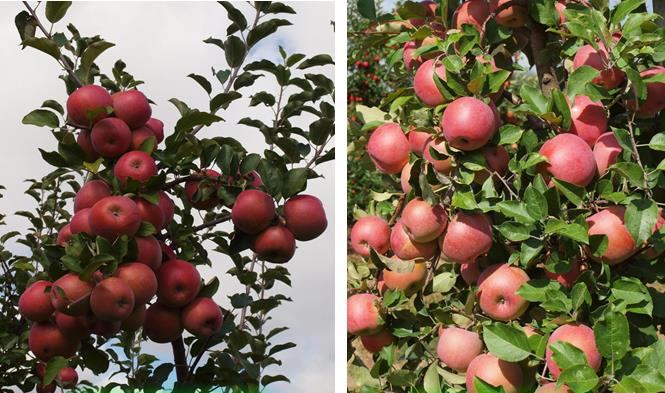

Clones
Fuji is a very popular variety. Many gardeners and breeders became interested in him and decided to breed clones. Today there are about a dozen of them.
The most famous:
- Aztec;
- Kiku;
- Yataka;
- Red (Nagafu);
- Toshiro;
- Cancer-Cancer;
- Beni Shogun;
- Fubrax.
Aztec
Fuji apple clone, Aztec, bred in New Zealand in 1996. Differs in regular fruiting.
Apples are juicy, rich red, with a sweet taste and juicy pulp, weighing up to 200 g. Fruits are stored for up to 7 months.
They begin to ripen in the second half of September, pollinated by the Gremi Smith variety, moderately resistant scab.
Kiku
A medium-sized, high-yielding winter Kiku clone recently bred in Japan. It ripens in the second half of October and is highly winter-hardy. Well suited for growing in temperate zones.
The fruits are large, weighing 250-300 g, the surface is pink, the taste is sweet with sourness. The tasting characteristics are even superior to the original.
Yataka
Yataka apples have a carmine-red peel with pronounced stripes, weigh 250-350 g. They taste sweet and sour, have a long shelf life and are suitable for processing. Ripen in the first days of October, a little earlier than the main variety.
Productivity is high, ovaries sometimes require thinning. Immunity is weak, prone to scab, powdery mildew, fire blight.
Red (Nagafu)
Ripening begins in the last decade of September. The fruits are red with a raspberry tinge. It tastes sweet, weighing 250-300 g.
Differs in good keeping quality and transportability, high winter hardiness. Trees of medium height, regular fruiting.
Toshiro
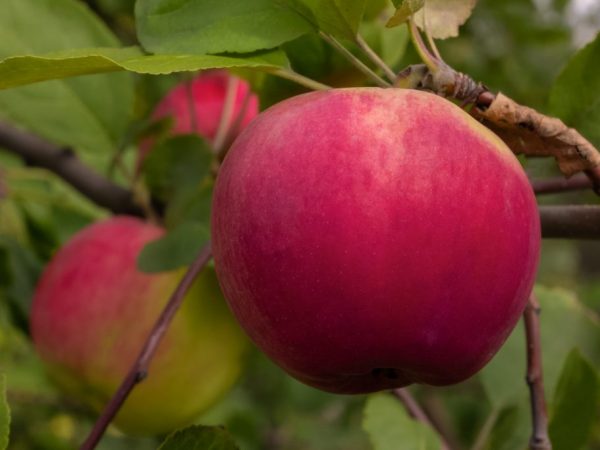

The Toshiro variety is grown commercially
Distributed in China, Japan and Korea, it is grown on an industrial scale.
Toshiro is also suitable for the climate of the Moscow region. Ripens at the end of September.
Fruit weight - 200-250 g, the surface is pink-red. Immediately after collection, they have a pronounced acidity, which disappears until the end of September.
Cancer-Cancer
A medium-sized tree with a lush crown. Fruits are round or slightly elongated, have a blurry pink color with pronounced yellow subcutaneous dots.
The taste is dessert, the pulp is tender and juicy. The clone is scab resistant, sensitive to powdery mildew.
Beni Shogun
Secondary clone, descended from Yataka. Beni Shogun is especially popular in the USA.
Differs in good winter hardiness, resistance to powdery mildew and rust, sensitive to scab. The apples are large, weighing up to 350 g.
The peel is bright red, the middle is white, the taste is pronounced sourness, the aroma is bright and pleasant.
Fubrax
Fubrax apples are large, green in color with a red-violet or pink blush covering the surface of the fruit in stripes. Ripening period - end of September. Taste is harmonious, dessert, aroma is expressed.
There are disadvantages - irregular fruiting, sensitivity to scab and fire blight.
Growing in regions
The variety was developed in Japan, but now it has spread all over the world. It is especially popular in China and Korea, but it began to take up more and more space in European intensive gardens.
To get delicious, sweet Fuji apples, there should be a lot of sunlight in the growing region, with its lack, apples do not ripen and do not gain sugar content.
It is not suitable for cultivation in the Central regions of Russia, Belarus and the northern regions of Ukraine.
And here are his clones (Fujik, Kiku, Yataka, Beni Shogun, Nagafu, Toshiro), ripening 2 to 3 weeks earlier than the main variety and having good winter hardiness, show good commercial qualities of fruits when grown in the above regions.
Rootstock options
Fuji can be grafted onto different rootstocks grown from seeds.
Since the original tree is tall and requires a lot of space, its species are becoming more and more popular among gardeners - dwarf and columnar.
Dwarf
The height of the dwarf rootstock is not more than 2.5 m. In the place where the tall species grows, 6 small ones can be planted. He begins to bear fruit as early as 3 years old. At 10 years old, it reaches its maximum performance. Lives up to 20-25 years.
The compact size helps save space in the garden. It is easier to harvest from low apple trees, it is easier to care for them. Since the roots of the dwarf rootstock are short, it is regularly watered. Mulch must be made on the trunk circle.
Columnar
The columnar rootstock has no lateral branches, the shoots grow upward almost parallel to the trunk.
Such an apple tree takes up very little space, the distance when planting between individual specimens can be 50-80 cm.
In place of one large tree, 10-12 columnar trees are planted. Often they are tied to a net so that thin branches and trunks do not break under the weight of the fruit.
The first crop appears already in the second year. At 7-8 years old, fruiting is the most abundant. By the age of fifteen, the apple tree is depleted.
Suitable for industrial cultivation. Allows you to quickly change varieties if the manufacturer sees changes in market demand.

